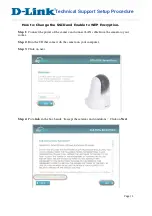
17
Dallmeier electronic
DDF3000AV4-DN / DDF3000AV4-D
Drill holes for dowels at the 3 marked locations.
Detach the remaining mounting template.
Insert appropriate dowels into the drilled holes.
Loosen (counter-clockwise) the 3 housing screws (T20 Torx) and remove the camera
housing.
Pull all required cables suspended from the ceiling/wall through a PG16 cable gland.
Screw the PG16 cable gland in the appropriate thread (see Fig. 5-1).
Mount the housing base with the 3 mounting screws (4×25mm oval/fillister head screw
with cross recess) to the ceiling/wall using the mounting holes (
A
WARNING
Danger of death from lightning strike!
Do not connect / disconnect the video cable during a thunder-
storm!
WARNING
Danger of death from electric shock!
Disconnect the power supply unit from the mains socket before
connecting the camera!
NOTE
In order to comply with the UL requirements, you have to use a
UL-certified, limited power source (LPS) Class 2 power supply
unit.
NOTE
The camera is provided with internal inverse-polarity protec-
tion.
Connect the camera via terminal (
J
, see Fig. 5-2) or UTP port (
H
) to an appropriate power
supply unit and a CVBS or UTP device. Ensure the correct pin assignment.
NOTE
For pinout information see chapter
.
Select the relevant video output type using the UTP/BNC switch (
F
).
Connect the power supply unit to the mains socket.
If necessary, connect the camera to a CVBS monitor using the video preview output
(
C
).
Loosen the locking screws (
D
), (
E
), (
G
) and (
K
Adjust the camera and lens using the 3-axis mount (see Fig. 5-1).
Adjust the focal length and focus.
Check the video image on the CVBS monitor.
















































